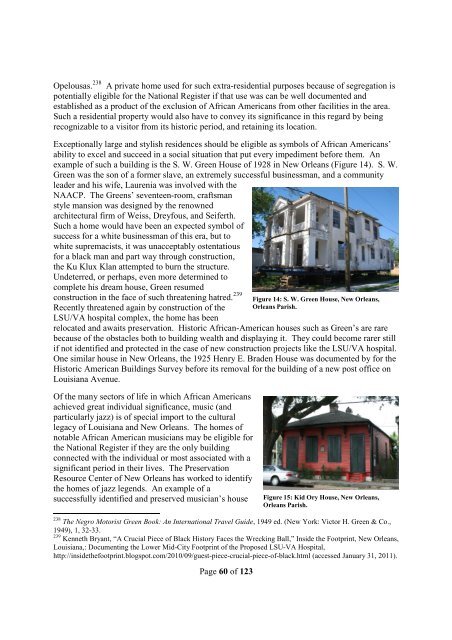The African American Experience in Louisiana
The_African_American_Experience_in_Louisiana
The_African_American_Experience_in_Louisiana
- No tags were found...
Create successful ePaper yourself
Turn your PDF publications into a flip-book with our unique Google optimized e-Paper software.
Opelousas. 238 A private home used for such extra-residential purposes because of segregation is<br />
potentially eligible for the National Register if that use was can be well documented and<br />
established as a product of the exclusion of <strong>African</strong> <strong>American</strong>s from other facilities <strong>in</strong> the area.<br />
Such a residential property would also have to convey its significance <strong>in</strong> this regard by be<strong>in</strong>g<br />
recognizable to a visitor from its historic period, and reta<strong>in</strong><strong>in</strong>g its location.<br />
Exceptionally large and stylish residences should be eligible as symbols of <strong>African</strong> <strong>American</strong>s’<br />
ability to excel and succeed <strong>in</strong> a social situation that put every impediment before them. An<br />
example of such a build<strong>in</strong>g is the S. W. Green House of 1928 <strong>in</strong> New Orleans (Figure 14). S. W.<br />
Green was the son of a former slave, an extremely successful bus<strong>in</strong>essman, and a community<br />
leader and his wife, Laurenia was <strong>in</strong>volved with the<br />
NAACP. <strong>The</strong> Greens’ seventeen-room, craftsman<br />
style mansion was designed by the renowned<br />
architectural firm of Weiss, Dreyfous, and Seiferth.<br />
Such a home would have been an expected symbol of<br />
success for a white bus<strong>in</strong>essman of this era, but to<br />
white supremacists, it was unacceptably ostentatious<br />
for a black man and part way through construction,<br />
the Ku Klux Klan attempted to burn the structure.<br />
Undeterred, or perhaps, even more determ<strong>in</strong>ed to<br />
complete his dream house, Green resumed<br />
construction <strong>in</strong> the face of such threaten<strong>in</strong>g hatred. 239<br />
Recently threatened aga<strong>in</strong> by construction of the<br />
LSU/VA hospital complex, the home has been<br />
Figure 14: S. W. Green House, New Orleans,<br />
Orleans Parish.<br />
relocated and awaits preservation. Historic <strong>African</strong>-<strong>American</strong> houses such as Green’s are rare<br />
because of the obstacles both to build<strong>in</strong>g wealth and display<strong>in</strong>g it. <strong>The</strong>y could become rarer still<br />
if not identified and protected <strong>in</strong> the case of new construction projects like the LSU/VA hospital.<br />
One similar house <strong>in</strong> New Orleans, the 1925 Henry E. Braden House was documented by for the<br />
Historic <strong>American</strong> Build<strong>in</strong>gs Survey before its removal for the build<strong>in</strong>g of a new post office on<br />
<strong>Louisiana</strong> Avenue.<br />
Of the many sectors of life <strong>in</strong> which <strong>African</strong> <strong>American</strong>s<br />
achieved great <strong>in</strong>dividual significance, music (and<br />
particularly jazz) is of special import to the cultural<br />
legacy of <strong>Louisiana</strong> and New Orleans. <strong>The</strong> homes of<br />
notable <strong>African</strong> <strong>American</strong> musicians may be eligible for<br />
the National Register if they are the only build<strong>in</strong>g<br />
connected with the <strong>in</strong>dividual or most associated with a<br />
significant period <strong>in</strong> their lives. <strong>The</strong> Preservation<br />
Resource Center of New Orleans has worked to identify<br />
the homes of jazz legends. An example of a<br />
successfully identified and preserved musician’s house<br />
Figure 15: Kid Ory House, New Orleans,<br />
Orleans Parish.<br />
238 <strong>The</strong> Negro Motorist Green Book: An International Travel Guide, 1949 ed. (New York: Victor H. Green & Co.,<br />
1949), 1, 32-33.<br />
239 Kenneth Bryant, “A Crucial Piece of Black History Faces the Wreck<strong>in</strong>g Ball,” Inside the Footpr<strong>in</strong>t, New Orleans,<br />
<strong>Louisiana</strong>,: Document<strong>in</strong>g the Lower Mid-City Footpr<strong>in</strong>t of the Proposed LSU-VA Hospital,<br />
http://<strong>in</strong>sidethefootpr<strong>in</strong>t.blogspot.com/2010/09/guest-piece-crucial-piece-of-black.html (accessed January 31, 2011).<br />
Page 60 of 123


